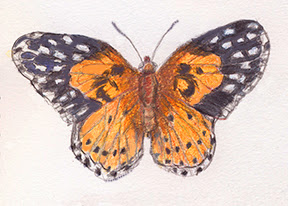I found this leaf in the woods upstate and what I loved about it
was how it was in the midst of transformation--turning from green to gold to yellow.
I noticed that the lower edge near the stem got yellow before the top. Leaves change color when days get cooler and
shorter and the auxin production ends, so the chlorophyll breaks down, and in
the birch leaf (like this one, maybe Betula
alleghaniensis or Betula lenta)
the carotene shines through as yellow.
Photographing the
actual leaf next to my drawing pointed out my shortcomings in a big way. I realized that I had made the base of the
leaf too narrow. I had to adjust my drawing. I made my yellow/gold a little dark, but
color depends on light and in some lights, the leaf looked darker than in
others. I adjusted but dark
over light can get muddy, so I had to be careful. The paper also started to curl from the water. This simple alternate leaf has a short
stem, toothed edges, and veins that meet and radiate from a
central vein. Here it is in my sketchbook. I knew I could not get all
the details right, but drawing nature is about that—details, details,
details. I draw to learn.






